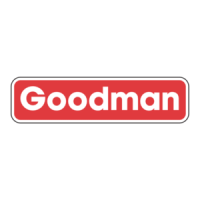
Do you have a question about the Goodman xMVM97 Series and is the answer not in the manual?
Critical warnings regarding installation, operation, and potential hazards like fire, shock, and CO.
Steps to prevent damage to electronic components from static discharge during handling.
Details on furnace features, ComfortNet compatibility, and modulating operation.
Guidelines for residential, commercial, and construction site heating usage.
Criteria for selecting a suitable furnace location, including clearances and air supply needs.
Importance of proper airflow for combustion to prevent CO hazards and ensure performance.
Specific requirements for installing the furnace horizontally, including suspension.
Details on necessary kits for propane conversion and high altitude operation.
Approved materials and proper procedures for joining vent and combustion air piping.
Regulations for the placement of vent and combustion air intake terminations.
Tables detailing pipe size, length limits, and elbow counts for vent systems.
Procedures for installing and priming the condensate drain trap for proper operation.
Instructions for routing the drain line from the right or left side of the cabinet.
Specific drain connections for horizontal installation with right or left side down.
Guidelines for connecting the main 115V power supply, ensuring proper polarity and grounding.
Steps for moving the electrical junction box for side panel connections.
Wiring diagrams and DIP switch settings for various thermostat types.
Wiring and setup for optional dehumidistat control to improve cooling dehumidification.
Instructions for wiring electronic air cleaners and humidifiers to the furnace control board.
Requirements for propane conversion and high altitude operation, including derating.
Guidelines for connecting the furnace to the building's gas piping, including unions and drip legs.
Procedures for leak testing gas connections using soap solution or electronic detectors.
Safety recommendations and pressure considerations for propane gas systems.
Method for measuring total external static pressure to ensure proper airflow.
Chart specifying minimum recommended filter sizes and importance of maintenance.
Step-by-step instructions for initial furnace startup, including thermostat settings and burner inspection.
Operation sequence when using a CTK01 communicating thermostat for heating.
Step-by-step instructions for starting and safely shutting down the furnace.
Procedure for measuring the gas supply pressure at the furnace inlet tap.
Method for measuring and calculating the furnace's natural gas input rate.
Guidelines for selecting and adjusting blower speeds to achieve correct temperature rise.
Introduction to the ComfortNet system, its components, and digital communication.
Table detailing DIP switch functions for various system configurations and settings.
How airflow demands are managed in ComfortNet systems, including demand sources.
Wiring diagrams for connecting CTKO thermostats and other system components.
Interpretation of red and green LEDs for network communication status and potential issues.
Step-by-step process of furnace operation during heating and cooling calls.
Description of safety circuits like primary limit, auxiliary limit, and rollout limits.
Essential steps to protect electronic components from static discharge.
Methods for resetting the furnace after a lockout condition.
Key items to check during an annual inspection for optimal performance and safety.
Importance of proper filter maintenance and recommended replacement procedures.
Information on how to order replacement parts, including necessary details.
List of error codes, their causes, and corrective actions for non-communicating systems.
Further details on error codes, causes, and corrective actions.
Additional error codes and their troubleshooting steps.
More error codes and troubleshooting guidance.
Final set of error codes and troubleshooting steps.
List of status codes displayed by the furnace and their meanings.
Detailed wiring diagram showing all electrical connections for the furnace components.
Specific requirements for gas-fueled equipment installations in Massachusetts, including CO detectors.
